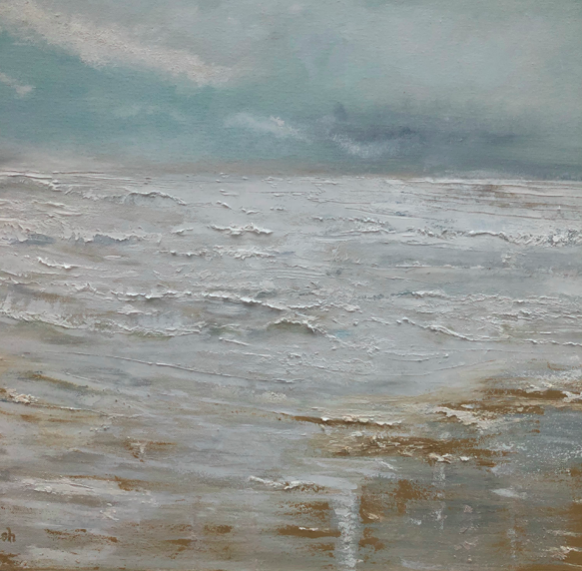“We are part of nature…”
Paul Zimmerman in conversation with Sue Walsh
Paul Zimmerman: How did you develop interest in art?
Sue Walsh: I remember when I was a toddler and drew a pan as a wobbly rectangle with a line sticking out that my parents showed their pleasure and put it up on the wall.
As I grew up I was encouraged to share their interest in the arts and to be creative. At sixteen I opted to study A-level Art and Art History at school.
I had already visited my aunt and uncle in France, visiting Versailles and the Paris galleries at ten years old.
So my perception of self has involved being an artist and engaging with the arts since I can remember.
PZ: Nature is often present in your paintings. Why is it important?
SW: We are part of nature and can’t be separated from it. When I paint I am conscious that the materials I use to make my paintings are derived from nature: hog hair brushes, pigments made from rocks for example. This idea is somehow linked to my experiences of growing up in the countryside, affinity with the seasons, mutability, regeneration, us being of the World rather than in it. Practically, I have spent all my life looking at rocks, water, trees and being in the landscape, building dens, smelling woodlands and experiencing Nature.
PZ: What is the most challenging aspect of your work?
SW: The honest answer has been affording the materials and the time to devote to painting. This is easier now. I had my studio built in 2010 and thus the freedom to spread out artistically both physically and mentally. Recently the constraints of living in lockdown will most likely affect what I can paint en plain air but I’m up for the challenge.
PZ: What is your artistic process? How do you create your paintings?
SW: The preparation is conscious looking and feeling so that the subject is imprinted in memory. Awareness of colour, light and form is essential. I spend time getting to know the idea of what I’m going to do to get started. After that it’s best described as creating a visual poem. I try to put in the essentials for the viewer to engage with the piece, “read” it and respond. Some pieces are done quickly whereas others take years and I sometimes chop up bigger pieces to create new ones. I use Michael Harding oils on canvas for the richness of the colours and the quality of the medium or Sennelier oil sticks which I apply with my fingers on board or paper. I use retouching varnish towards the end though I do add more paint on top and revarnish if the painting needs it even after it has been framed.
PZ: How do you know when a painting is finished?
SW: It’s mostly down to internalised decision-making which manifests as intuition. When this happens there is a deep satisfaction and happiness that the piece is ready for viewing.
That’s when I add my signature. For most pieces the importance of the frame can’t be over-estimated.

PZ: How has your practice changed over time?
SW: It has been helpful to study and collect art that is of interest to me. Since the 1980’s I have studied and collected art from the St Ives Artists of the 20th century, such as Patrick Heron, Sandra Blow, Wilhelmina Barnes-Graham Barbara Hepworth and Ben Nicholson.I am an associate member of the Penwith Society Of Artists in St Ives, Cornwall and have exhibited in their shows and in the town for a number of years. Since 2017 I have begun to exhibit where I live in Chester, Cheshire at Chester Art Centre and have recently joined Place For The Arts in Chester.
PZ: How would you describe yourself as an artist?
SW: I am a collector, student, practitioner, collaborator. Among other things I collect shells, pebbles, postcards, books and paintings. I read about artists, visit their studios and exhibitions, collect their work and immerse myself in art.I value when someone tells me why they like or dislike a piece of my work. I particularly value feedback that confirms that my “visual poetry” is accessible. The fellowship of my artistic friends in Cornwall, Chester and New York and our plans for the future sustain me.
PZ: How would you define art?
SW: I approach this question with caution. I can’t give a true definition in half a dozen sentences due to the necessity for conceptual pluralism. The foundation stone of my definition is that art partners science in humankind’s meaningful and successful existence.
PZ: What are you working on now?
SW: I planned my 2021 Summer exhibition to be a collaboration with a local poet and a visit to Scotland. I have the poems and the trip is booked.
Right now we are locked down so travel is not allowed. I am therefore getting to grips with organising: new canvases, portfolios, paints and brushes are ready for me to get going.
I will be submitting some paintings for consideration for the Penwith Society of Artists Spring Exhibition2021.
I also have a few smaller pieces that I am working on and have further plans for some larger pieces.
PZ: How does the pandemic influence your work and sensibility?
SW: I am finding that my thoughts lean towards the abstract as expressions of mood, atmosphere and inner consciousness.
I see this as an opportunity to experiment with colour and application.
I am beginning work on some large canvases using a new colour palette and bigger, gestural marks. I rely more on memory and sketches brought back from past occasions and look for the joy and, hopefully, create some too.
